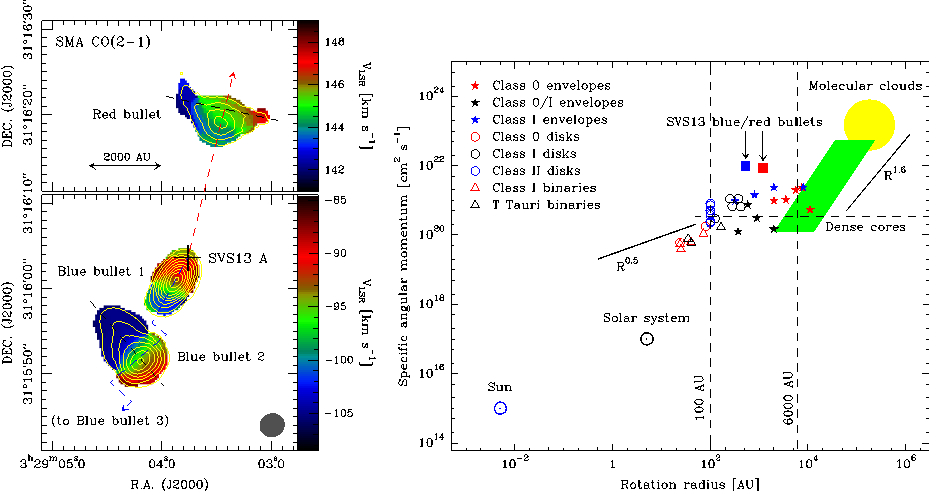Stars form from the gravitational collapse of dense cores in molecular clouds. It has been long recognized that in the star formation process specific angular momenta need to be reduced by six to seven orders of magnitude from a dense core to a typical main-sequence star, like the Sun. This puzzle has been regarded as the “angular momentum problem” in the field of star formation. Obviously, the extraction of excess angular momentum is essential in the star formation process.
In the early phase of star formation, when a young stellar object (YSO) accretes mass from its surrounding disk, it also ejects mass in a bipolar jet. The YSO jets are driven by rotating disks through magneto-centrifugal processes, although the precise origin of jets from YSOs is still in debate. The rotation of jets about their symmetry axis is then widely considered to be a key mechanism to remove angular momentum from forming protostars, and thus, at least partially, to solve the angular momentum problem in the star formation. However, the detection of jet rotation is extremely difficult, as both high angular and spectral resolution are required. In the past two decades, promising rotation jets candidates from a few TTauri stars have been observed. Nevertheless, there is no convincing detection of rotating jets/outflows from protostars yet.
Using the Submillimeter Array (SMA), Dr. Xuepeng Chen at the Purple Mountain Observatory and his colleagues recently present CO (2–1) line observations toward the protostellar jet driven by SVS13A, a Class 0/I transition protostar located in the Perseus NGC1333 star-forming region. SVS13A is well-known for driving an extremely high-velocity CO outflow, which records the highest velocity CO outflow known thus far. The SMA CO images show that the high-velocity SVS13A jet is composed of a series of molecular ‘bullets’. Based on the SMA CO observations, the research group discovers clear and large systematic velocity gradients, perpendicular to the jet axis, in the blueshifted and redshifted bullets, which are believed to result from the rotation of the SVS13A jet (see left panel of the figure). The estimated specific angular momenta of the two bullets are comparable to those of dense cores, about 10 times larger than those of protostellar envelopes, and about 20 times larger than those of circumstellar disks (see right panel of the figure). If the velocity gradients are due to the rotation of the SVS13A jet, the significant amount of specific angular momenta of the bullets indicates that the rotation of jets/outflows is a key mechanism to resolve the “angular momentum problem” in the field of star formation. The kinematics of the bullets suggests that the jet-launching footprint on the disk has a radius of about 7 AU, which appears to support the extended disk-wind model.

By with CHEN Xuepeng
Figure 1:(Left) The SMA CO velocity field of the SVS13A jet. (Right) Specific angular momentum as a function of different scales of a star-forming region. The specific angular momenta of the two rotating bullets from SVS13A are marked by red and blue squares.
This work was supported by the National Natural Science Foundation of China (grants Nos. 11473069 and 11328301) and the Strategic Priority Research Program of the Chinese Academy of Sciences (grant No. XDB09000000), as well as the Thousand Young Talents Program of China. The result was recently published by the Astrophysics Journal (see http://dx.doi.org/10.3847/0004-637X/824/2/72 ).
|
(Information Source: Purple Mountain Observatory, CAS) |

